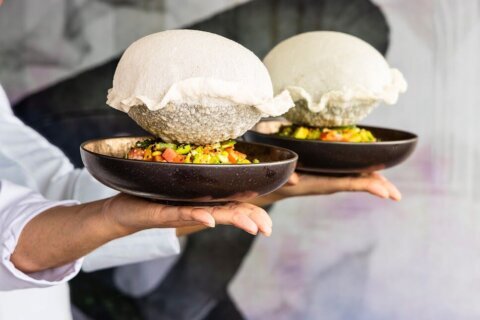All throughout May, WTOP is celebrating Asian American and Pacific Islander Heritage Month with stories about the people and places shaping the D.C. region.
For decades, Vietnamese food could be described in many ways, but words such as fancy or high-end were rarely used. But two award-winning chefs are changing that by putting a modern spin on family recipes they grew up with and giving diners a sense of what real Vietnamese food tastes like, even if it looks completely different.
And it’s working. Chef Kevin Tien, the owner of downtown D.C.’s Moon Rabbit, was named best chef in D.C. last year by the Restaurant Association of Metropolitan Washington. This year he’s a finalist for a prestigious James Beard Award.
He’s not the only one in the kitchen drawing accolades, though. Susan Bae, the pastry chef at Moon Rabbit, who is also Vietnamese American, is a James Beard Finalist, too. Together they’re helping to change the perceptions of what Vietnamese food is as a cultural cuisine, while reminding you how good it is.
“If you want traditional Vietnamese food, Eden Center is the place to go,” Tien said. “It’s probably one of the best Vietnamese food hubs in all the country. And for us, we’re not trying to do anything traditional at all.”
But he’s also not straying too far, nor is he doing anything “fusion.” Instead, he’s striving to be at the forefront of a cuisine that’s evolving, the same way so many other cuisines brought to the U.S. from overseas have.
“You’ll see food here and it looks nothing like Vietnamese food,” he said. “But it tastes exactly like Vietnamese food.”
His prime example is a riff off a Vietnamese soup called “banh canh cua,” a noodle soup with crab, pork and a noodle that’s thicker than what you might be used to. And instead of potato for the gnocchi, they use a potato starch.
“So the dish tastes very, I hate using this word, but I’ll say it, authentic,” he said. “But it looks nothing like a Vietnamese soup that you would expect to see.”
For Bae, “the flavors and the textures are there to mimic its original form, however, visually, it looks very different.”
Her desserts also burst with flavors from across Vietnam, even if the appearance, and some of the ingredients, aren’t traditional either.
“It’s visually presented to evoke nostalgic feelings of what Vietnam is in terms of it geographically. So the oceans, the nature surrounding the place, it’s visually there. So the feeling is there, the taste is there,” Bae said. “However, it doesn’t look very traditional.”
Tien said he strives to preserve the foundations of his family’s recipes and Vietnamese culture overall.
“I think there’s a very big difference in cooking food that is preserving culture, and new food or fusion food,” he said. “I think if you’re doing it the right way, you’re keeping the messaging and the history there. But if it becomes too fusion-y, I think that also becomes like a dilution of culture, which is not something we want to do.”

Tien and Bae represent the generation of Vietnamese Americans who grew up working class and started climbing the economic ladder to the middle and upper classes. Now they’re bringing the cuisine of their ancestors up that ladder with them.
“I don’t think that Asian cuisine should be considered cheap by any means, because it’s a labor of love,” Bae said. “There’s a lot that goes into infusing the flavors, creating aromatics, those are all processes required in Asian cuisine. And to think that it should be cheap or, you know, priced at a lower rate, I don’t think is fair because it’s a long process to get the final result.”
Tien added, “You have to know where we’re coming from to see where we’re headed.”
He later told a story about a family of Vietnamese Americans spanning three generations coming into his restaurant. When that happens, he watches the reactions of the grandparents to help judge if what he’s doing is working.
“It’s really fun to see a table like that, especially when I see grandparents really enjoy the food I’m like ‘oh good, I didn’t mess it up,'” he said. “They’re very proud to see that the culture is being pushed forward. And then it’s great to see current parents bring their kids in. They’re like, ‘Hey we want our kids to try Vietnamese food and see it done in a new way.’ It’s really great we get to be part of the process in other people’s lives, sharing culture and representing.”
As Tien helps Vietnamese food take that step forward, following similar advances in Japanese and Korean cuisine, he believes Filipino and Laotian is about to take off locally, too. The melting pot of America will allow more flavors from other cultures to have their moment too.
“Over time, different chefs and different people are opening restaurants to kind of bring their cuisine forward,” said Tien, who has been a semifinalist and finalist for James Beard Awards before, but has never won one outright. “This year, you saw the first Indian restaurant to ever get a Michelin star in the U.S. You kind of saw that with Korean food over the past couple of years as well and I think the next kind of steps would be a Michelin star for Southeast Asian restaurants.”
Get breaking news and daily headlines delivered to your email inbox by signing up here.
© 2024 WTOP. All Rights Reserved. This website is not intended for users located within the European Economic Area.








